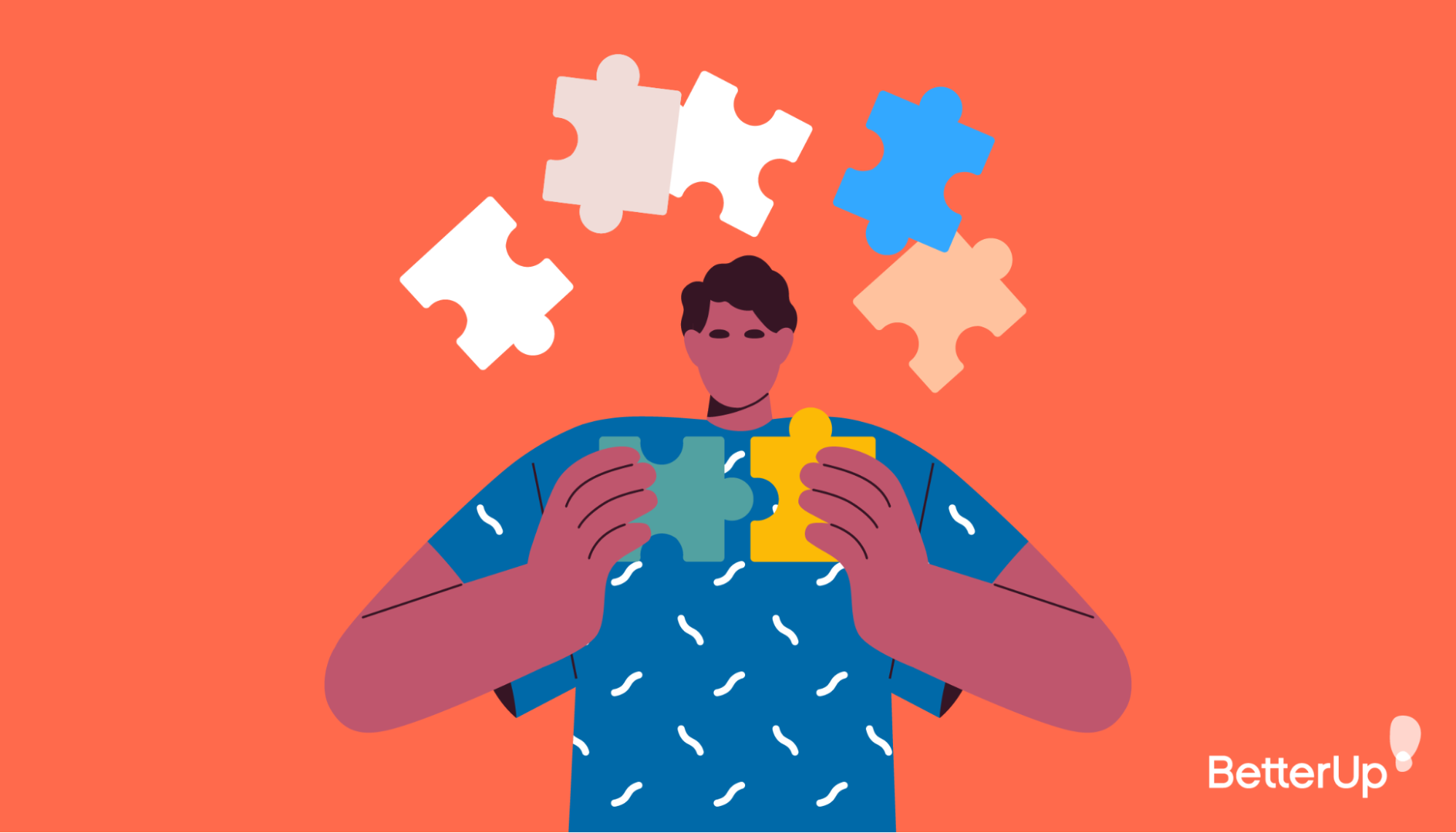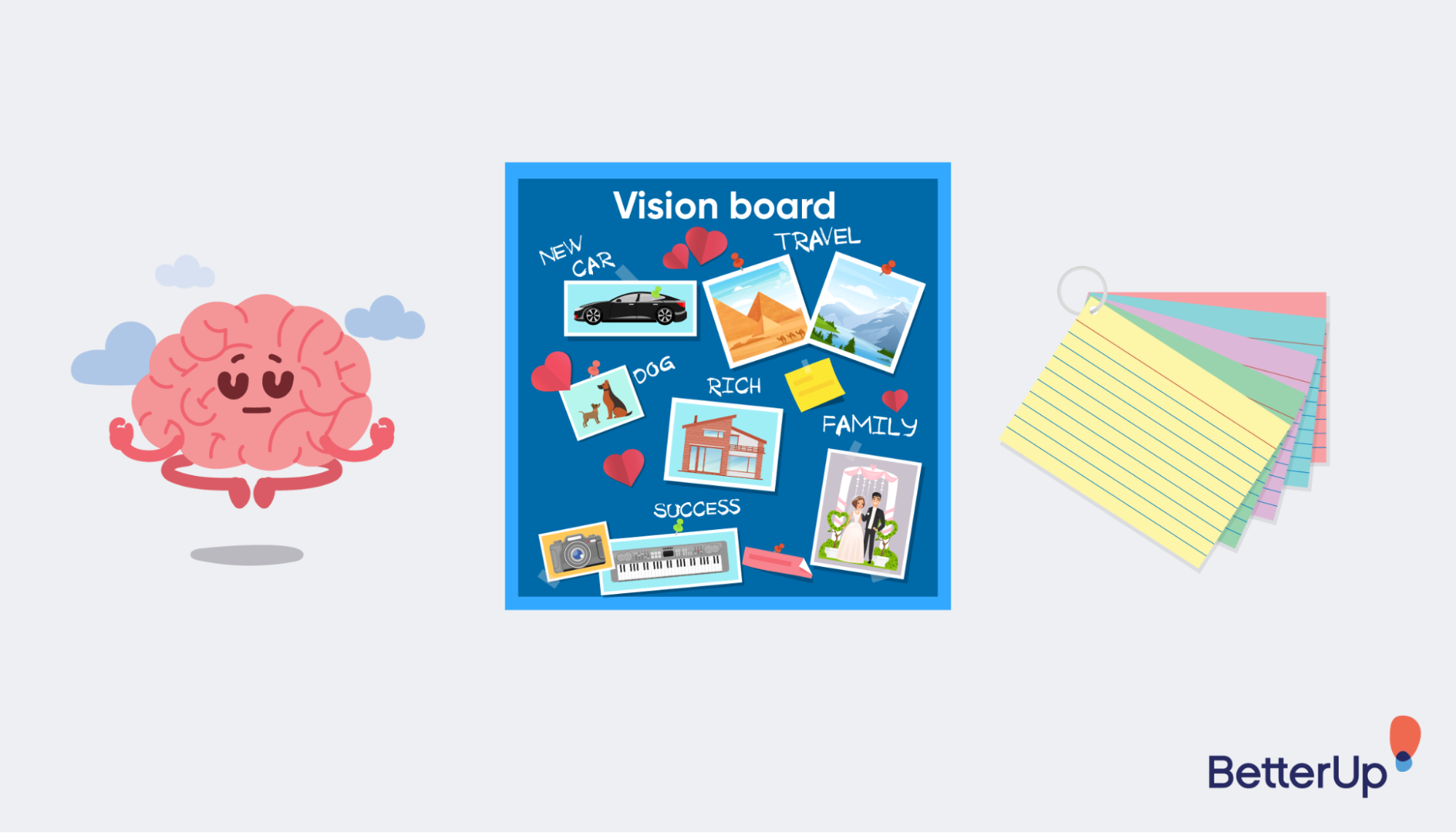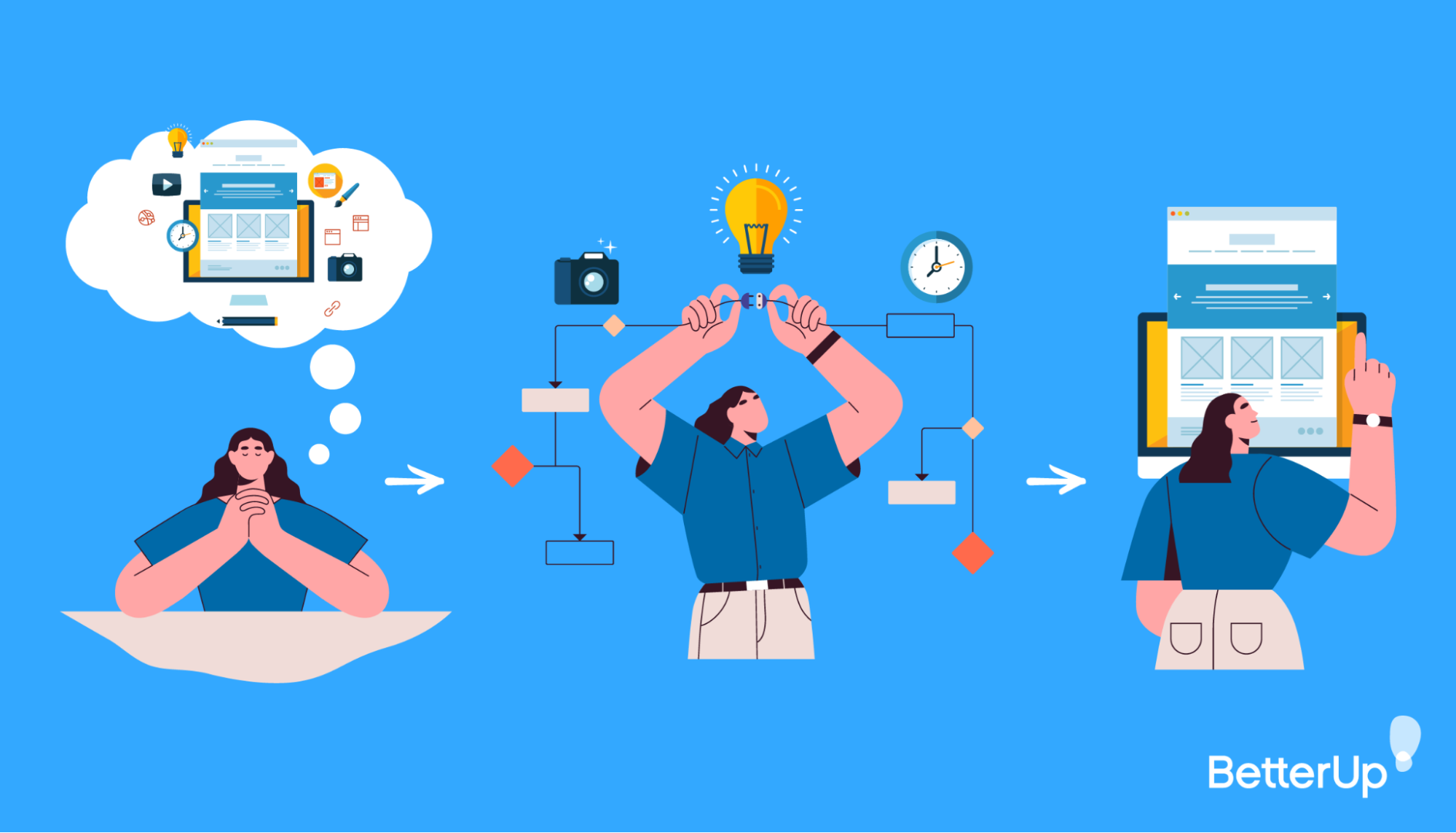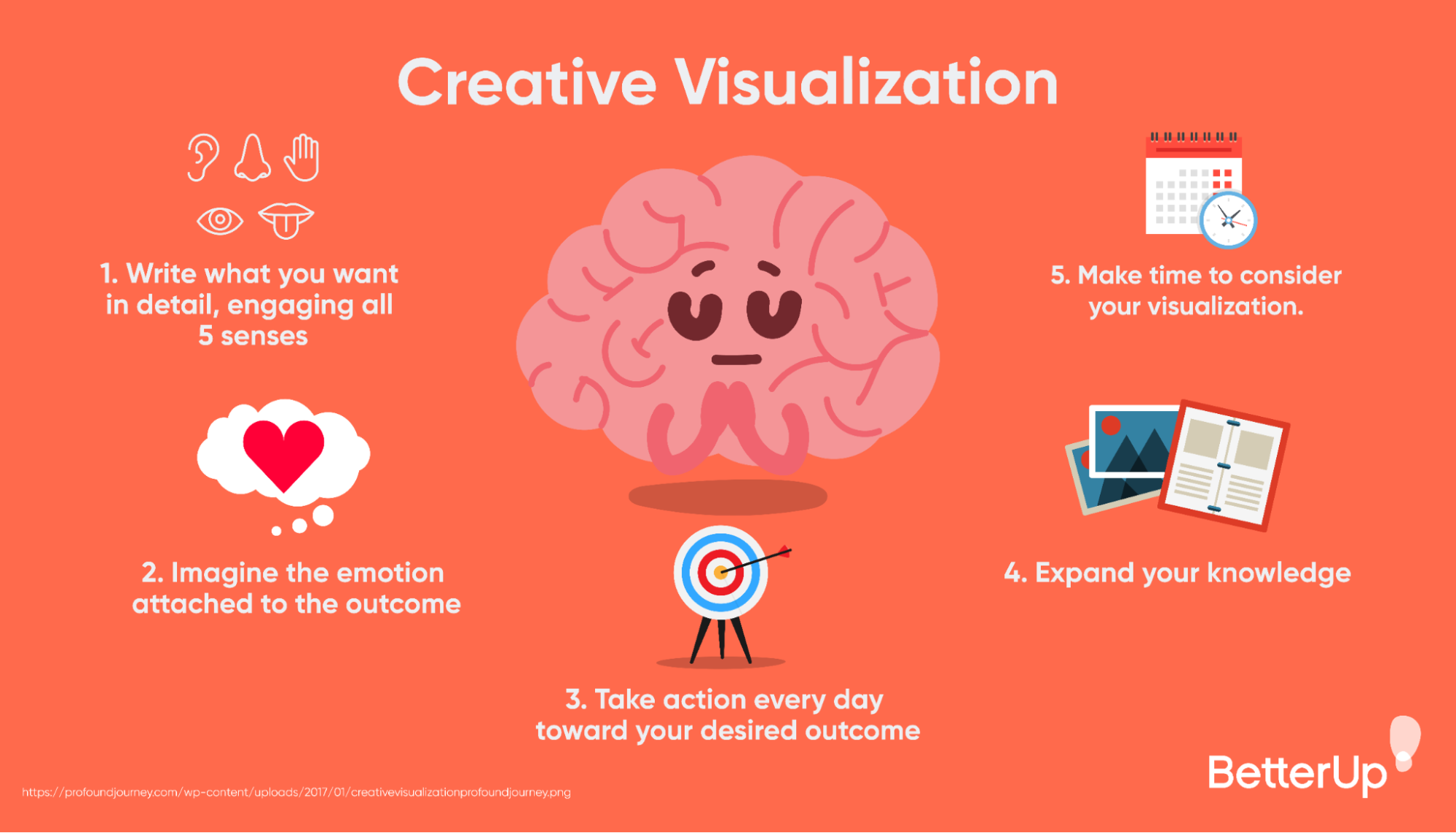Jump to section
What are visualization techniques for?
How do you visualize what you want?
Does visualization really work?
How do you practice visualization? 5 steps
Visualization techniques and tools: learn how to practice visualization
For Business
Products
Build leaders that accelerate team performance and engagement.
Drive productivity through sustained well-being and mental health for all employees with BetterUp Care™.
Solutions
Transform your business, starting with your sales leaders.
Foster a culture of inclusion and belonging.
Customers
See how innovative companies use BetterUp to build a thriving workforce.
Resources
Best practices, research, and tools to fuel individual and business growth.
View on-demand BetterUp events and learn about upcoming live discussions.
The latest insights and ideas for building a high-performing workplace.
Innovative research featured in peer-reviewed journals, press, and more.

Jump to section
What are visualization techniques for?
How do you visualize what you want?
Does visualization really work?
How do you practice visualization? 5 steps
Visualization techniques and tools: learn how to practice visualization
People around the world have been using various kinds of visualization techniques, meditations, and prayers for centuries. However, visualization often gets a bad reputation as being something mystical or woo-woo that isn’t grounded in reality.
But the truth is, you don’t need to be spiritual to benefit from visualization techniques. Visualization has been studied by psychologists to understand how it works.
And nowadays, everybody, from professional athletes to CEOs, are benefiting from visualization techniques.
Let’s take a look at what visualization is and why it’s important. Then we’ll outline some visualization techniques that you can start using yourself.
Visualization is the practice of imagining what you want to achieve in the future. As if it were true today.
It involves using all five senses of sight, smell, touch, taste, and hearing. The process of visualizing directs your subconscious to be aware of the end goal you have in mind.
It reminds you on a consistent basis. And it trains your brain to respond as if that outcome were true in the present moment.
There are two types of visualization:
(1) outcome visualization: envisioning the desired future end-point, and
(2) process visualization: envisioning every step toward that desired outcome. With all the senses engaged.
When the two visualizations are used in tandem, they yield the best results.

We live in a world of digital overload. There’s a constant cycle of news and entertainment. Plus, remote work is available with the click of a button. It’s easy to become distracted.
It's easy to believe that there’s not enough time in the day. You just want time to step back and focus on the things that matter to you the most.
In his presentation Unleash Your Super Brain to Learn Faster, Jim Kwik offers a great set of metaphors.
You can choose to be either a thermostat or a thermometer. The thermostat responds to the environment. The thermometer sets the temperature and creates the desired condition.
Visualization is a technique that allows you to set the parameters to make your future vision a reality.
In creative visualization, you direct your brain to focus on what matters the most to you. And to engage in a process called selective attention.
Have you ever bought a car and then noticed that everyone else seems to be driving that same car? We see the things that we choose to focus on. This concept of selective attention is exemplified in the classic video Test Your Awareness: Do the Test.
What you focus on and take deliberate steps toward are more likely to become a reality.
That’s true in both the positive and the negative.
Have you ever imagined the worst possible outcome? Along with all the visceral fear, and then it actually came true?
What if you changed that to the best possible imagined outcome. With the related elation and full sensory awareness?
For the answer, we can look to cognitive behavior theory. Visualization is built on the foundation it teaches that thought precedes action.
Visualization is a technique that takes that idea one step further. In imagining the future state in full sensory detail, your brain’s neuroimagery records the future state as if it's true today.

Visualization can be used to motivate you to focus on, and work toward, your future ideal state.
It can be used to build your self-confidence.
Imagine yourself presenting in front of a large audience and hearing the resounding applause. You’re likely to believe, and act in a way, to make it happen.
Visualization can also be used as a form of mental rehearsal. Through process visualization, you increase selective attention. And engage the mental pathway that helps you to fine-tune the movement before you even step onto the stage.
Your movements are envisioned. And, in a way, programmed to take the pre-planned actions. You can add these actions to a longer-term plan 5-year plan.
Visualization techniques can also reduce anxiety. They direct your attention back to the details of your desired outcome. In the process, minimizing the noise of other (less relevant) distractions.
Sign up to receive the latest insights, articles, and resources you can use today.
Thank you for your interest in BetterUp.
First, you have to do the pre-work.
An excellent place to start is the Balance Wheel exercise.
Check in on your satisfaction levels with the various areas of life.
Is your life wheel balanced, or does an area need attention?
Next, become clear of the values that act as your North Star.
Do you value family, career, and money? Or travel, adventure, and freedom?
How do those values impact the decisions you make?
Finally, take some time to do some positive thinking. Use your imagination through reflective writing prompts in the Best Possible Self exercise.
Who'd you want to be when you were little? Who are you today? Is it the same or a different version?
Also, consider when you were energized and felt most engaged and alive. What was it about that time that invigorated you? What mattered about that moment?
Take a piece of that moment and imagine the future state you want. Try to get to that same feeling of excitement and emotional intensity.
Imagine where you are and what you are doing. Who's around you? How do you feel? What smells are in the air, and what tastes are on your tongue? What are your thoughts at that moment? If you believe your thoughts, it's possible. If you don’t, it’s not.
With an understanding of what matters to you most, and why, you're ready to begin the practice of visualization.

Google the term “visualization.” Lists of elite athletes come up who have had to put mind over matter to achieve their athletic goals.
They’ve learned to focus on the critical movements before they ever step into their competitive arena.
For example:
They understand that mental exercise is just as important as physical exercise.
Stroke victims have used the mental exercise of visualization to activate neuroplasticity. Just doing it mentally works in a way similar to physical activity.
Visualization is illustrated in the Netflix series Queen’s Gambit.
Chess prodigy Beth Harmon rises the ranks by first being exposed to the game. Then deciding she wants to master the game. She reads all the books about chess.
She masters all the plays that she can get her hands on. She keeps practicing, then goes to sleep and visualizes nightly the moves of the upcoming chess match with all of her senses.
Watch a dancer prepare for her dance offstage. Marking the movements with her feet and arms as she plays the dance out in her head. The dancer performs and then watches the dance replayed on video with judges’ comments.
She takes the adjustments and practices. Then visualizes a process repeated over and over again. Both as mental imagery and physically.
Do you remember a time when you imagined the outcome clearly? The steps you took to make it happen. Did it end up happening just as you imagined?
Then you know that it wasn't a matter of wish fulfillment. There was desire front and center that guided your thoughts and behaviors. Your neuronal pathways. Toward that desired, imagined, and fulfilled outcome.

Here are five steps to get you started on your visualization practice:
Ready to unlock the potential in your organization?

Learning visualization can be tricky. Here are five tools and techniques you can use to learn how to practice visualization successfully:
This visualization tool is a collection of images and words that inspire you and represent your goals. It serves as a visual representation of what you want to achieve.
Place your board somewhere you'll see every day. That way, you'll be constantly reminded of what you're working towards.
Youtube is full of free guided meditation videos. An interactive visualization can help you to relax and set some time aside to focus on your goals. Guided imagery helps give you something to focus on.
Do you remember using flashcards as a kid? Maybe you used them to learn math or words. As an adult, we can use index cards in a similar way as a tool for visualization.
Make a list of 10 or 20 goals that you're currently working toward. Write each one on an index card and keep it near your bed.
Every morning and every night, go through the stack of cards. One at a time. Read each card, then close your eyes and visualize yourself completing that goal.
The more detail you use when visualizing, the more real it'll feel to you.
It's one thing to get a quick thought that you want a slice of pizza. It's entirely different to really allow yourself to obsess about it.
Think how much more real it seems if you take a few minutes to imagine how it'd taste, feel, and smell to eat a slice of pizza right now.
Create as specific of a mental image as possible. Try to provide your brain with as many details about your goal as possible. More detail means a better solution.
Exposing yourself to things related to your goals can help make it more real for you.
Maybe one of your goals is to go parachuting. If you've never done it before, it's hard to imagine exactly what it's like.
Watch some videos of other people parachuting. Read accounts people have written about parachuting online. Or talk to people who have tried it. All of these things will increase your knowledge about it and make it feel more real for you.
Try out a visualization technique from the list above. Your selective attention will be directed toward fulfilling your vision.
You'll be the thermostat creating the condition that's just right for you.
Stay up to date with new resources and insights.
Thank you for your interest in BetterUp.
Visualization can help you make better decisions and get what you want out of life.
It’s hard to make progress toward your goals if you don’t take some time to think about them.
Set some time aside to use the techniques we’ve shared. They'll provide you with actionable insights into achieving your goals.
BetterUp can help you find your focus and purpose. Discover your strengths and achieve your life goals with a personalized BetterUp coaching experience.
Products
Solutions
Customers